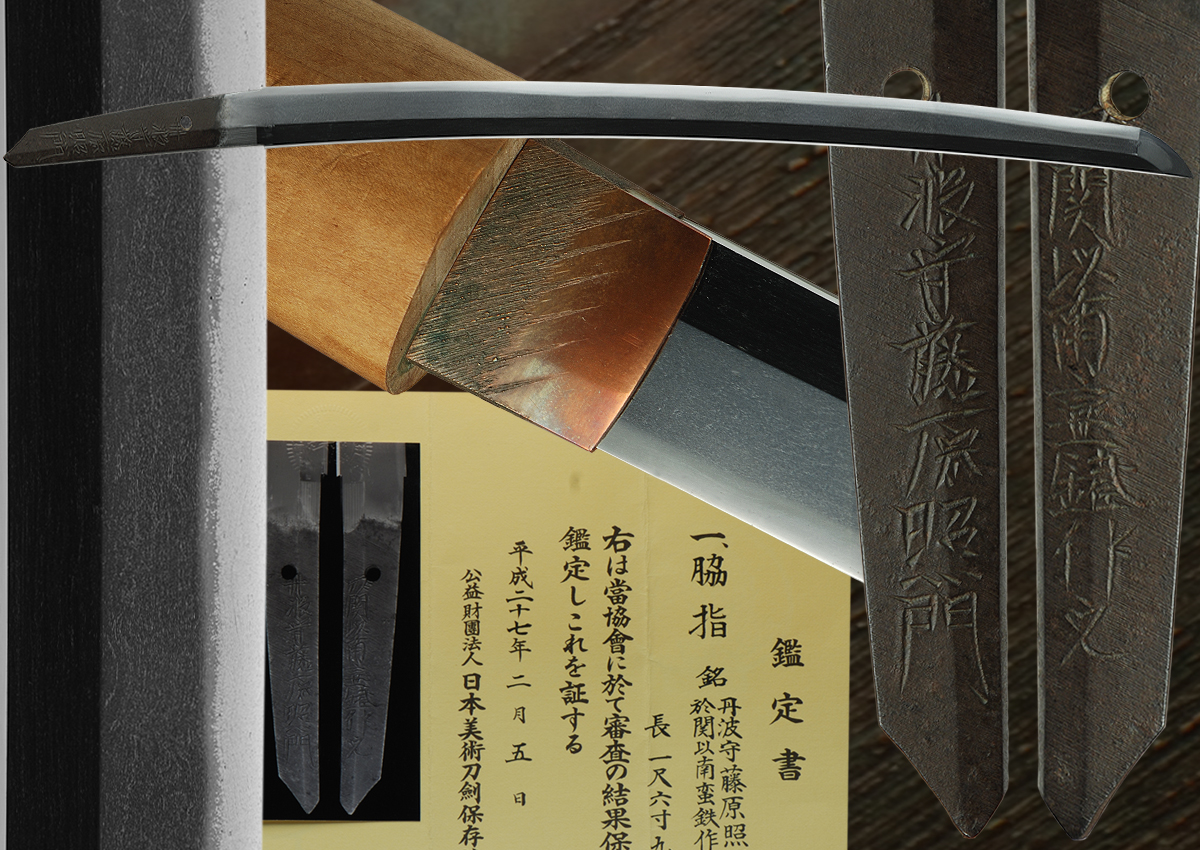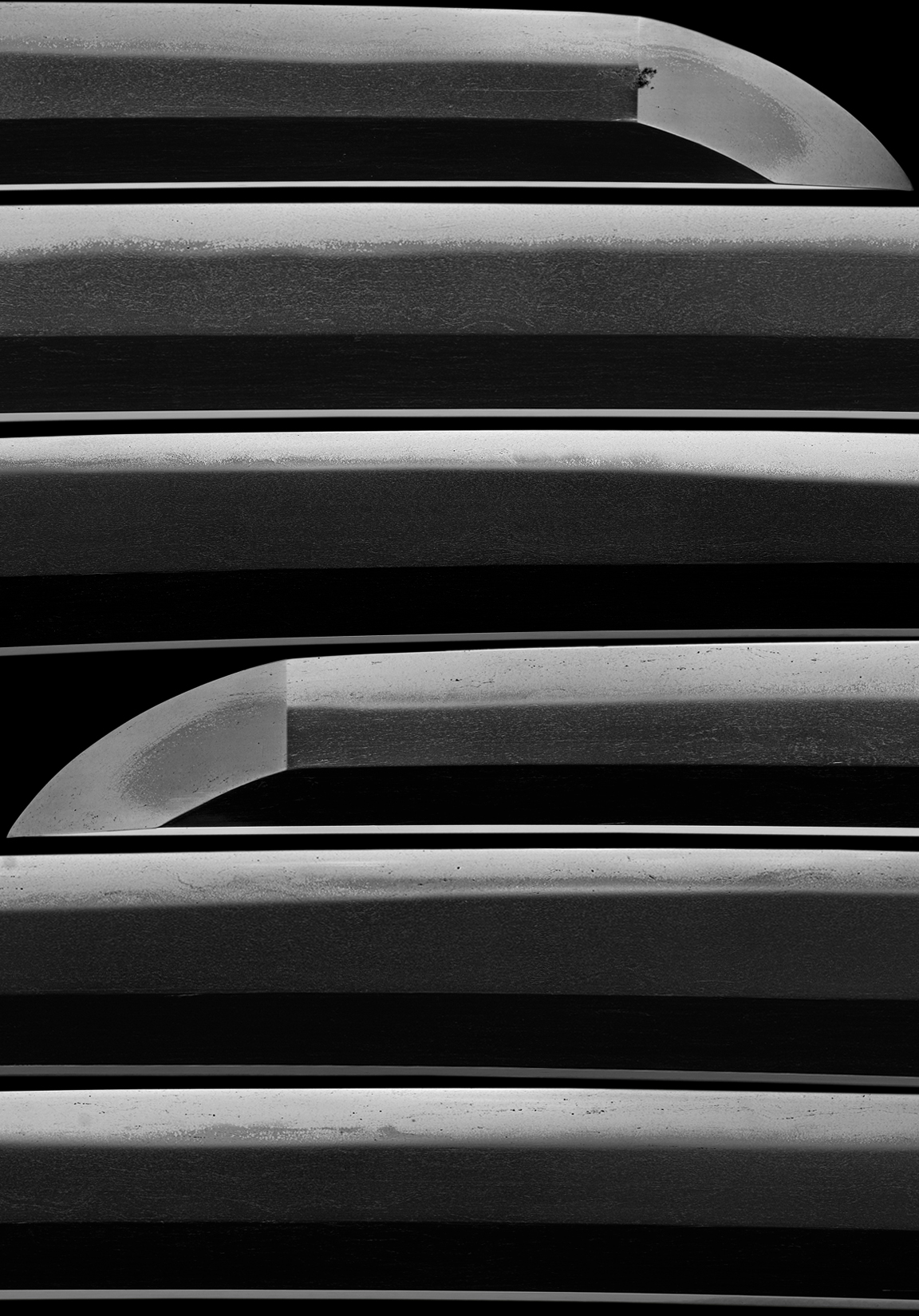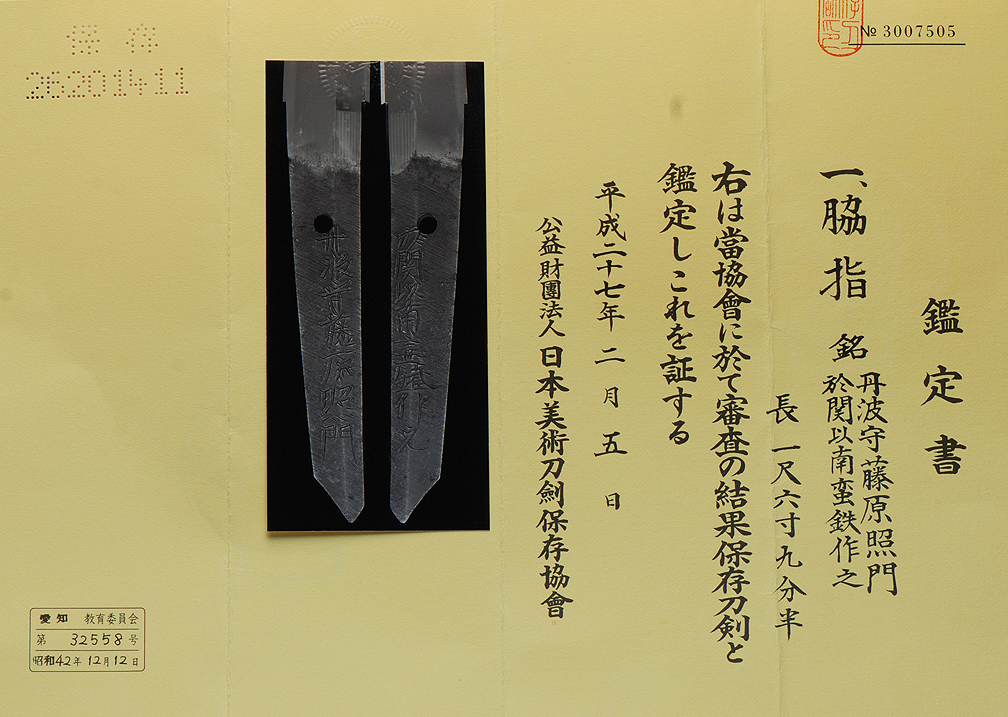A unique and beautiful sword signed ”
Tanba no Kami Fujiwara Terukado
Seki ni oite nanban-tetsu o motte kore o saku
This swordsmith was prolific in his use of many forms on Nanban-Tetsu. He is listed as a 60 point smith in Hawley’s and as you can see his work has much to be desired by true connoisseurs. The hada is a masterful example of his use of a dense Itame / Mokume blend with Masame in the shinogi-ji. The hamon is chu-sugu-ba with much activity that can be seen. There is sunagashi and kinsugi as well. The blade’s hamon is Nie-Deki frosted in Nie as can be seen and finished with a Nie-Hotsure which make the habuchi appear like a frayed piece of cloth which is a text book example of this activity produced by this smith. Terukado also signed KaneKado on his extent pieces. He is listed as working in Mino 1658-1684. He was also considered one of the Zenjo smiths and listed as Seki-Kaji-Toryo ” master of all Seki smiths”. The Tegai influence is easily recognized within this work. This particular tang has a very distinctive Iriyamagata-Jiri which he was known for. It reminds one of a flipper from a fish. The blade has a striking original rain pattern copper habaki.
Terukado is listed in the Shinto Meikan
Fujishiro ranks him as chûjô-saku and in the Tôkô Taikan he is listed with 380 man Yen.
This is what Fujishiro has to say:
TERUKADO TANBA NO KAMI [KANBUN 1661 MINO] SHINTÔ CHÛJÔSAKU
He is in the Nôshû Seki Yoshisada Ha, and he also produced in Seishû Kuwana and Edo. His style is like that of Bungo no Kami Masakane.
Signatures: TANBA NO KAMI FUJIWARA TERUKADO
TANBA NO DAIJÔ FUJIWARA TERUKADO
Plate III: OITE SEKI YOSHISADA SAKU KORE
Plate IV: TANBA NO KAMI FUJIWARA TERUKADO
All in all a wonderful higher ranking Shinto smith constructed with Barbarian steel ‘ Nanban-Tetsu. Papered by the NBTHK and in a very nice Japanese polish and Shirasaya. A new fresh polish would greatly enhance this already beautiful blade. A longish Wakazashi and a spectacular blade to enjoy.
- Mei:Tanba no Kami Fujiwara Terukado / Seki ni oite nanban-tetsu o motte kore o saku
- Date: Edo (1600’s)
- Nagasa: 20-1/4 inches
- Sori: 10.0 mm
- Width at the ha-machi: 29.7 mm
- Width at the yokote: 21.8 mm
- Thickness at the mune-machi: 7.1 mm
- Construction: Shinogi zukuri
- Mune: Iori
- Nakago: Ubu
- Kitae: dense itame/mokume blend
- Hamon: sugu-ha hotsure
- Boshi: Maru hakikake
- Condition: Good polish minor stains
Email us if your interested in this item and remember to include the order number for this item: fss-697.
kantei-sho (鑑定書) No 3007505 wakizashi, mei: Tanba no Kami Fujiwara Terukado (丹波守藤原照門)
Seki ni oite nanban-tetsu o motte kore o saku (於関以南蛮鉄作之)
nagasa 1 shaku 6 sun 9 bu han
Migi wa tô-kyôkai ni oite shinsa no kekka, hozon-tôken to kantei-shi kore o shô-suru. (右は當協會に於て審査の結果保存刀剣と鑑定しこれを証する)
Heisei nijûnananen nigatsu itsuka (平成二十七年二月五日)
kôeki-zaidan-hôjin (公益財團法人): Nihon Bijutsu Tôken Hozon Kyôkai (日本美術刀劍保存協會)
Appraisal
wakizashi, signed: Tanba no Kami Fujiwara Terukado
Made in Seki by using nanban-tetsu
According to the result of the shinsa committee of our society we judged this work as authentic and designate
it as hozon-tôken. February 5th 2015 [Foundation] NBTHK
TERUKADO (照門), Manji (万治, 1658-1661), Mino
Terukado’s real name was Mitsui Sô’emon (三井惣右衛門), although he is also listed with the first name Sôkurô (宗九郎). He was from the old-established local Mino Zenjô School and started his career by signing with Kanekado (兼門). He changed his name to Terukado (照門) when he received his honorary title of Tanba no Daijô (丹波大掾) in Manji two (1659), a title that was shortly later, i.e. in Manji three (1660), raised to that of a Tanba no Kami (丹波守). When the local Ujifusa lineage (氏房) – the lineage that was so far head of the representative Mino Zenjô School – relocated to Nagoya (名古屋) in Owari province, their local honorary title Seki-kaji-tōryō (関鍛冶頭領, lit. “master of all Seki smiths”) was given to the lineage of Kanekado. It has to be noticed that Terukado’s successors did not continue his name but stayed with the initial name of the lineage, i.e. with Kanekado. Terukado himself did not only work in Seki in Mino province but also in Kuwana in Ise province and in Edo. Fujishiro ranks him as chûjô-saku and in the Tôkô Taikan he is listed with 380 man Yen.
For Sale
























